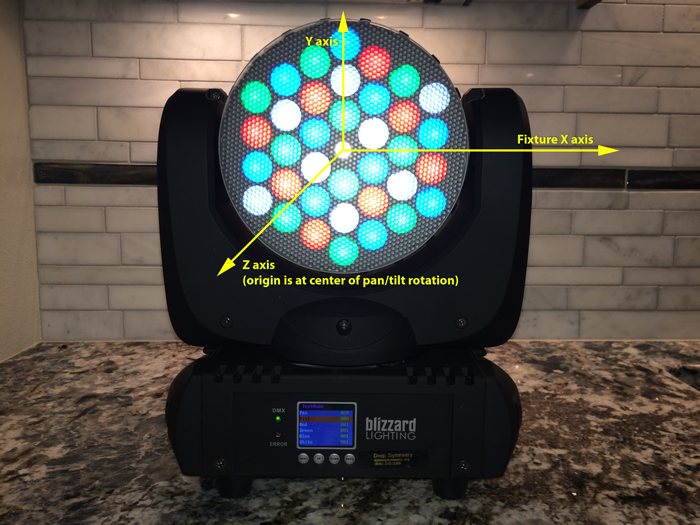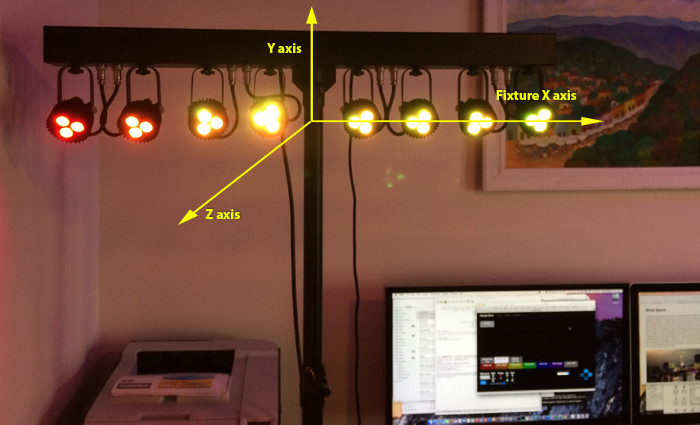afterglow.fixtures.blizzard
Definitions for fixtures provided by Blizzard Lighting.
blade-rgbw
(blade-rgbw)(blade-rgbw mode & {:keys [hung version-2], :or {hung 0}})Blade RGBW moving head. The default patching orientation is sitting on its feet with the LCD and control panel right side up and facing the audience. In this orientation, at a pan of 0, the beam is straight into the audience.
The origin of the light is, as for all moving heads, at the intersection of the pan and tilt axes. That is the point that you need to reference when patching the fixture and telling Afterglow where it has been hung within show space. The image below shows this default orientation, and the axes, for the fixture. If it is hung with this side of the base facing the audience, right side up, then you do not need to specify any rotations when you patch it. Otherwise, tell Afterglow how far it has been rotated around each of the axes when hanging:

If you are hanging the light at an odd angle, or for any reason it is harder to measure the exact axis location given where where you are hanging it, you can supply an optional argument :hung after the mode argument, containing the distance in meters from the origin in the photo to the point at which it was hung (the center of the bar it is clamped to), and Afterglow will calculate where the head is based on that distance and the orientation at which you reported it hung. With the standard clamp mount and a standard O-clamp that distance seems to be twelve inches.
The center pan value (aimed straight at the audience when hung in the default orientation described above), is defined as 84, a half revolution around from that, so that it has room to move in both directions from its resting point. It takes a change of +84 in the pan channel to rotate a half circle counterclockwise around the Y axis.
At the center pan setting of 84, the center tilt value is 8, aiming the head straight out at the audience. At this position, it takes a change of -214 in the tilt channel to rotate a half circle counterclockwise around the X axis. (In other words, it can essentially only tilt clockwise from here.)
This fixture can be configured to use either 11 or 15 DMX channels. If you do not specify a mode when patching it, :15-channel is assumed; you can pass a value of :11-channel for mode if you are using it that way.
The way these fixtures respond to pan and tilt values seems to have changed in a major revision in 2015. If you have a more recent model, you can pass a true value with the optional keyword argument :version-2 after mode, in which case the center pan value is 82, the center tilt value is 25, and it takes a change of -230 in the tilt channel to rotate half a circle counterclockwise around the Y axis.
pixellicious
(pixellicious)4x40 LED pixel tile in 480 channel mode. The default orientation is facing the audience, with the long axis parallel to the X axis, and the controls and LED panel right-side up on the back side.
puck-fab5
(puck-fab5)(puck-fab5 mode & {:keys [mix-amber], :or {mix-amber true}})Puck Fab5 RGBAW LED.
This fixture can be configured to use either 3, 5 or 12 DMX channels. If you do not specify a mode when patching it, :12-channel is assumed; you can pass a value of :3-channel or :5-channel for mode if you are using it that way.
When you pass a mode, you can also control whether the amber channel is mixed in when creating colors by passing a boolean value with :mix-amber. The default is true.
torrent-f3
(torrent-f3)Torrent F3 moving head effects spotlight. The default patching orientation is sitting on its feet with the LCD and control panel right side up and facing the audience. In this orientation, at a pan of 0, the beam is straight into the audience.
The origin of the light is, as for all moving heads, at the intersection of the pan and tilt axes. That is the point that you need to reference when patching the fixture and telling Afterglow where it has been hung within show space. The image below shows this default orientation, and the axes, for the fixture. If it is hung with this side of the base facing the audience, right side up, then you do not need to specify any rotations when you patch it. Otherwise, tell Afterglow how far it has been rotated around each of the axes when hanging:

The center pan value (aimed straight at the audience when hung in the default orientation described above), is defined as 85.5, half a revolution around from that, so that it has room to move in both directions from its resting point. It takes a change of -85.5 in the pan channel to rotate a half circle counterclockwise around the Y axis.
At the center pan setting of 85.5, the center tilt value is 25, aiming the head straight out at the audience. At this position, it takes a change of -203 in the tilt channel to rotate a half circle counterclockwise around the X axis. (In other words, it can only tilt a little counterclockwise from here, but can flip right over in the clockwise direction.)
If you are wondering why you are getting no light from a torrent, note that you need to explicitly set the shutter to open before the dimmer has any effect. Try something like:
(show/add-effect! :torrent-shutter
(afterglow.effects.channel/function-effect
"Torrents Open" :shutter-open 50
(show/fixtures-named "torrent")))
weather-system
(weather-system)(weather-system mode)Weather System 8-fixture LED bar. Even though this fixture does not move, it is important to patch it at the correct orientation, so Afterglow can properly reason about the spatial relationships between the eight individual heads.
The fixture origin is right between the fourth and fifth head, at the level of the lenses. The default orientation is with the bar parallel to the X axis, and the LED display and sockets all facing away from the audience.

This fixture can be configured to use either 7 or 26 DMX channels. If you do not specify a mode when patching it, :26-channel is assumed; you can pass a value of :7-channel for mode if you are using it that way.